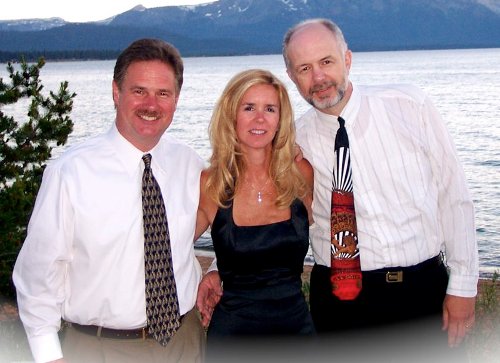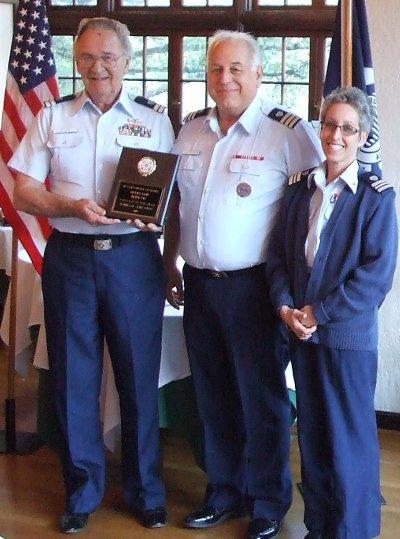
The badly damaged Beats Workin' II, photographed on August 27, 2009, shortly before it was released from evidence by the Lake County Sheriff's Office. Photo by Elizabeth Larson.
LAKE COUNTY – On the morning of Thursday, Aug. 20, following six hours of jury deliberations, 13 days of testimony and 51 witnesses, a Lake County jury acquitted a Carmichael man of charges that he had been responsible for a fatal boat crash three years and four months earlier.
Bismarck Dinius, 41, hugged his attorney, Victor Haltom, in relief after the verdict from the nine-man, three-woman jury was read.
While the verdict brought an end to a long and complex criminal case, it also would open a new chapter in Dinius' story, one that will include a federal civil rights lawsuit set to be filed against the county of Lake early in the new year.
On that August morning, the jury found that Dinius was not guilty of felony boating under the influence causing great bodily injury or a misdemeanor count of boating under the influence. The jury deadlocked 11-1 on a misdemeanor count of boating with a blood alcohol level of more than 0.08, a charge later dismissed.
Dinius had been at the tiller of the sailboat Beats Workin' II, owned by then-Willows resident Mark Weber, on Clear Lake on the night of April 29, 2006, out for an evening sail with friends following the Konocti Cup sailing races earlier that day.
On board were Weber's longtime girlfriend, Lynn Thornton, 51, and two new friends she had invited along – Zina Dotti and Ed Dominguez.
At about 9 p.m., as the sailboat was heading back across Konocti Bay to its mooring point at Richmond Park Bar & Grill – where Konocti Cup participants had gathered for a post-race dinner earlier that evening – the sailboat was hit from behind by a powerboat driven by Russell Perdock, an off-duty sheriff's deputy, who was accompanied by his friend, James Walker, and Walker's teenager daughter, Jordin.
Weber and Dinius both were seriously injured, as was Jordin Walker. Thornton died a few days later at UC Davis Medical Center due to blunt force trauma injuries to the head.
While Perdock wasn't charged, Dinius was. District Attorney Jon Hopkins alleged that Dinius had blood alcohol level of 0.12 at the time of the crash and that he had failed in his duty to have the sailboat's navigation lights on. A test had found Weber had a blood alcohol level of 0.18.
Haltom's experts – including Dr. William Chilcott – maintained the sailboat's lights were on, and that they had been knocked out when Perdock's powerboat – estimate to be traveling around 45 miles per hour – hit the sailboat, traveled up its mast and landed in the water on the boat's other side.
The trial drew worldwide attention, particularly from the sailing community, whose members felt that Dinius was being targeted in an effort to protect Perdock.
The case gained increasing attention since it was filed in 2007, almost exactly a year after the crash had occurred. That initial filing had included a manslaughter charge that Hopkins dismissed in July, about a week and a half before the trial started on July 28. Hopkins said, in doing so, that it was his opinion that the civil case settlement resolved the issues of responsibility for Thornton's death.
“Our first reaction was one of utter shock and, really, of outrage,” said Rick Thomsen, one of Lynn Thornton's older brothers who lives in Texas. “We thought, they're charging Bismarck Dinius and not Russell Perdock?”
Carol Stambuk, a close friend of Thornton's and the executor of her will, said Thornton – who at the time of her death had just retired from her job as an investigator with the state dental board – was “beyond safety conscious,” and she wouldn't have invited Dotti and Dominguez out on an unlit sailboat. Neither would Weber have gone out without the required running lights, she said.
Rick Thomsen agreed, noting his sister was very careful. “If she would have seen it was unlit, she would have said something.”
Roger Thomsen, Thornton's oldest brother, said after the crash, the first thing he asked Weber was if the lights were on. He said Weber looked him in the face and said yes, they were.
Thornton's friends and family said they wanted to share information with authorities, but weren't given the chance. So instead they wrote letters to the court and to Hopkins, which they said weren't acknowledged.
Hopkins said this week that he stands by the decisions he made in the case.
“The difficulty with the case was that the law regarding boating under the influence specifically states that the operator of a vessel is the person steering it,” he said this week.
While that's easy to understand where someone is steering a motor boat – because it's much like a car – Hopkins said the situation with a sailboat operator is much more complex, but there is not a separate definition for operating a sailboat.
“Our position was that since the law says the person steering the vessel is subject to the boating under the influence laws, that person was Dinius and it was his responsibility to be sober enough to know what he was in charge of as the helmsman steering the sailboat,” Hopkins said. “The owner of the sailboat was not steering, so he couldn’t be prosecuted for boating under the influence.”
Although he said many people wanted Perdock prosecuted simply because he was a deputy sheriff rather than the strength of the evidence, he said Perdock's blood was tested before Dinius' was and Perdock was found to have no alcohol in his system.
“There were really only two options for a prosecutor, turn your back on a case where an intoxicated person was the operator of a sailboat without running lights at night where another person was killed, or prosecute the intoxicated operator,” he said.

The Baja powerboat owned by Russell Perdock that collided with the Beats Workin' II on April 29, 2006. The boat was photographed on August 27, 2009, after the conclusion of the trial and before it was released from evidence by the Lake County Sheriff's Office. Photo by Elizabeth Larson.
Case moves to trial
In 2008, Haltom had staged a tough defense during a preliminary hearing that stretched across four days in May and June, but in the end it was left up to a jury to decide.
The trial was set to begin May 19, with Judge J. Michael Byrne, a retired visiting judge, presiding.
But Deputy District Attorney John Langan, who was handling the case at the time, had filed a motion for a delay, seeking more time to investigate new information that he had received that indicated Perdock may have been at Konocti Harbor Resort & Spa in the hours before the crash, and that a deputy had corroborated former Sgt. James Beland's allegation that he was ordered not to give Perdock a breathalyzer test at the scene. Perdock's blood test occurred at St. Helena Hospital Clearlake.
During a May 19 hearing, Langan told the court he was concerned that he wouldn't be able to complete an in-depth investigation into the information, and stated that 911 calls in the crash had been purged. He indicated he might dismiss the case at a June 12 hearing.
“It's a possibility given the amount of investigation that we believe we would need to ethically do now before presenting a trial that would be fair to both sides,” Langan said at the time.
But Langan didn't get the chance to dismiss the case. At the June 12 hearing, Hopkins appeared, having taken over the case the previous week. At that time, Hopkins told the court the case would continue.
Over the following month, the sheriff's office would discover copies of the 911 tapes in the case, which Lake County News reported in an exclusive July 6 story. The information was disclosed to Lake County News as part of a Freedom of Information Act request filed for information about the 911 tapes.
When it finally began, the trial stretched over a month, as Hopkins and Haltom argued facts and battled over the allegations.
While Dinius was in the courtroom every day, he wasn't the only one on trial. The sense throughout the proceedings was that two men were being tried – Perdock in absentia, and Dinius in person. At times, Haltom seemed more of a prosecutor and Hopkins a defender, as Haltom attempted to focus the blame on Perdock.
Haltom told Lake County News this week that the majority of the discovery evidence he received from the prosecution was provided after the trial started.
Perdock had been scheduled to testify as a prosecution witness on Aug. 6, but Hopkins surprised the court by resting his case without calling Perdock to the stand. It later emerged that Hopkins had been notified that Perdock – on medical leave since June – was the subject of an internal affairs investigation.
Haltom called Perdock to the stand on Aug. 11. At that time, Perdock spent about an hour and a half on the stand, and during testimony maintained he had not set foot at Konocti Harbor Resort & Spa that day.
When the verdict was delivered to a hushed and crowded courtroom on Aug. 20, it was greeted with relief by the defense team and Thornton's friends and family, who said they were happy for Dinius.
“The right decision was made,” said Stambuk.
“My reaction to the verdict was, finally he gets justice,” said Roger Thomsen. “Thank God Dinius got off, and thank God the people of Lake County didn't buy into what the prosecutor was saying.”
Rick Thomsen was off from work on the day the verdict came in. He said he and his family in Texas stood around the computer and watched the Twitter updates come through from Lake County News and Bay Area reporter Dan Noyes.
“It was so weird, we kept saying to each other, this is like our verdict,” He said. “We were so nervous.”
He added, “It was like a family member of ours was on trial.”
Dinius said he and his wife greeted the verdict with joy and exhaustion.
“We were pretty confident that there wasn't a jury in the world that was going to convict me,” he said.
Weber said the verdict came out the way he had hoped, but he emphasized that it never should have gone to trial.
He also had taken the stand, and said he had been eager to do so after nearly three and a half years of keeping silent due to fears he also might be prosecuted.
Haltom said that, to him, the injustice of the prosecution was compelling to him.
“To this day, I can't figure out what made Lake County authorities tick,” he said.
He believes, as he asserted in court, that there was an effort to protect Perdock at the expense of Dinius.
“They had to know he was not guilty of causing Lynn's death,” Haltom said of his client.
Haltom, who also was strained financially by devoting himself entirely to the case, has gotten back to work in his own practice.
But he's far from done with the case.
He and the Northern California Innocence Project – which worked with him on Dinius' trial – are assisting Berkeley attorney Lawrence Masson in a civil rights case expected to be filed next month against the county of Lake. They've compiled a “mountain of documents” – Haltom estimated there are 10,000 pages of information compiled in the case so far.
The action will include a defamation filing against Hopkins – who before the trial issued a public letter on his reasons for pursuing the case – and also will name Sheriff Rod Mitchell, Perdock and some other individuals within the Lake County Sheriff's Office and the District Attorney's Office.
“The ground work has been laid,” he said.
Masson couldn't be reached for comment on Thursday.
While the verdict was a relief, it couldn't bring back Thornton, a beloved partner, mother, sister and friend.
“The person who killed my sister is still out there,” said Roger Thomsen, referring to Perdock.
“We're still grappling with, what about Lynn?” Stambuk said.
In the case of Perdock, Mitchell confirmed to Lake County News this week that he still has not returned to work after being placed on medical leave in June.
Officials defend their work on the case
Hopkins said if Perdock had been charged, his attorney would have argued that he was sober, his speed couldn't be proved beyond reasonable doubt, that a reasonable speed would have resulted in the death, that all the witnesses to the collision said that the sailboat did not have its running lights on and that Dinius and Weber – both of whom were determined to be intoxicated – were responsible for the death.
“There is no way any responsible prosecutor would have charged the chief deputy,” said Hopkins. “The only reason would have been political and designed to curry favor with some people.”
Hopkins said the negative publicity – which he called “the most extreme example of abuse of publicity in a criminal case that I have seen in my 38 years in the criminal justice system” – resulted in a lot of people basing their opinions about the case on misinformation. Attempts to pressure his office even resulted in personal threats.
“It disturbs me that people who don't know me and how committed I am to making the right decisions and seeking justice, make all these outlandish untrue claims that can impact the confidence our local people have in their system of justice,” he said. “It doesn't affect the way I approach my work, because I know who I am and intend to remain true to myself.”
Hopkins said he's believed throughout his career that he can't base decisions “on the whims of political opinion.” He added that, “Decisions motivated by fear are not in the best interest of public safety.”
Like Hopkins' staff, Mitchell's also received abusive messages and harsh criticisms about the case. “My staff took an undue beating,” he said.
He said he feels his agency is a good enough organization to learn from cases like this one. “We do have to learn things from it.”
There are things there will never been in his control, he said. “I don't think anything was going to change the outcome of that case.”
Mitchell said he worked to be transparent, and brought in outside agencies – including a Sacramento County Sheriff's investigator and the Attorney General's Office, which reviewed his handling of the case and didn't find issues. “The attorney general validated our process,” he said.
“The filing is what seemed to alter the course,” he said.
Many people believe the criminal case filing was an injustice, and they associated the investigation with that filing, he said. “I think the evidence shows we did an unbiased investigation.”
Shortly after the trial ended, Mitchell asked a three-person panel to gather questions from the community, which he answered and posted online at his Web site under “Debriefing: The Final Report – November 3, 2009” (www.lakesheriff.com/boat_case%20files/BoatCrashQA.asp ). The information was voluminous, and accompanied the sheriff's investigative files in the case.
Overall, he's received positive feedback from it, although he noted there is still confusion because of the sheer amount of information about the case.
Mitchell added of the case, “What I know to be true is nothing I would ever say for publication.”
Dinius deals with trial aftermath
Since the trial ended, Dinius said he's been coming to terms with the physical, emotional and financial impacts of his prosecution, all of which have been severe.
Even though the prosecution lost its case, Dinius said the case has left his life in ruins.
On May 18, he lost his job with Verizon, and with the Sacramento area's unemployment at nearly 18 percent, he's been unable to find work.
He's been trying to regroup, has sailed a little with a friend and said he's found out who his friends are – and who they aren't. He's grateful for the support from Thornton's family, and he said he thinks about her all the time.
Financially, “It's ruined me,” he said, noting his defense bills totaled about $300,000. While he's been unemployed he's struggled to pay off the experts in the case, but still owes Haltom – who worked the case full time for about six months before and during the trial – a large sum of money.
Dinius said the aftermath of the trial has been a difficult time.
“It really was the beginning of a different chapter,” he said. “It's been a struggle.”
“I feel so bitter about the district attorney and the sheriff's department and the way that they handled it and the way they treated me,” he said.
He said he's been very grateful for the financial support and notes of encouragement from people around the world, especially those in Lake County, for which he has a fondness thanks to that outpouring. He said he and his wife have been moved by the messages they've received.
“It's not over for me,” he said.

Lynn Thornton and her older brothers in happier times
LAKE COUNTY – The effects of the struggling economy were evident in Lake County in 2009, especially in the number of unemployed residents.
Although December's numbers won't be available until mid-January, the November unemployment rate for Lake County hit 17.7 percent, one of the highest rates seen locally in decades, based on California Employment Development Department records.
The county of Lake responded to the crisis by altering its vendor selection rules, placing the emphasis on local businesses, according to County Administrative Officer Kelly Cox.
Cox, who has been with the county since January of 1980, said he can't recall ever seeing unemployment rates so high in Lake County.
The numbers had crept up steadily over the year, dropping back slightly during the peak agricultural and tourism seasons in the late spring and summer. The lowest rate of the year was 14.8 percent in September.
But with news that one of the county's largest employers, Konocti Harbor Resort & Spa, was closing in November, the numbers jumped up again as the year wound down.
With the winter months proving to be slower for local employment, December's numbers, as well as those into the early months of the new year, could go higher still.
E-mail Elizabeth Larson at This email address is being protected from spambots. You need JavaScript enabled to view it. . Follow Lake County News on Twitter at http://twitter.com/LakeCoNews and on Facebook at http://www.facebook.com/pages/Lake-County-News/143156775604?ref=mf .

The historic stone wall in the foreground made for a great frame to this sunset show Miguel Lanigan took about half a mile west of Clearlake Oaks in December.
LAKE COUNTY – A good way to start the new year is with gratitude, especially for the beauty and natural wonders of Lake County.
Local readers are generous with contributions and pictures, and to start the new year off we've compiled a group of pictured submitted by readers over the past month.
Photos always are welcome; e-mail them to This email address is being protected from spambots. You need JavaScript enabled to view it. with information about who took the photos, when they were taken and where.
Follow Lake County News on Twitter at http://twitter.com/LakeCoNews and on Facebook at http://www.facebook.com/pages/Lake-County-News/143156775604?ref=mf .

A hummingbird visits a feeder at the home of Clearlake Oaks resident Miguel Lanigan, who snapped the shot in December.

Frank Hodges of Lucerne sent in this colorful sunrise captured in December.

Lucerne resident Lenny Matthews captured this sunset

Konocti Harbor Resort & Spa closed temporarily but indefinitely in November 2009. Courtesy photo.
KELSEYVILLE – In November, an era of music and entertainment ended in Lake County, when its premier resort, Konocti Harbor Resort & Spa, closed its doors.
The news that the resort would close temporary but indefinitely came to light in early September, after Boca Raton, Fla.-based WhiteStar Advisors LLC – an asset management company that was put in charge of overseeing the resort following a federal lawsuit that was settled in 2007 – began notifying local, state and federal officials of the closure.
As many as 700 employees – the resort's peak seasonal workforce – were estimated to lose jobs.
While the job losses inflated already high unemployment in the county, harder to quantify is the impact on other local businesses, which benefited from the concert goers that the resort drew.
The county also is losing significant transient occupancy – or bed – tax from the resort, according to county officials.
Also in September, the 90-acre resort was listed for $15 million with a local Realtor, a listing that later was canceled.
That sales price was $10 million below a sales price that had been established in 2007 with Page Mill Properties, after the federal Department of Labor's lawsuit was settled. The Page Mill deal later fell through.
Later in September, James Bishop, managing director of WhiteStar Advisors LLC, told Lake County News that the resort was under a sales contract, but he would not divulge the potential buyer or the price. That contract didn't involve a local Realtor, he said.
Since the September news of a sales contract, few new details about a potential new owner for the resort have emerged.
WhiteStar has not returned calls seeking comment on the resort's sales status. Greg Bennett, the resort's president and general manager, also could not be reached for comment.
County officials also haven't received details from WhiteStar, according to County Administrative Officer Kelly Cox.
Cox said the county communicated with the resort's owners and their representatives about assistance that the county may have been able to provide to help keep the resort from closing. He said the county may also be able to assist new owners.
“The current owners and their representatives are aware of the county's strong desire for the resort to have remained open,” he said. “They are also aware of our desire for the resort to reopen at the earliest possible date.”
Cox said the county has actively sought potential buyers for the resort and have arranged for them to meet with the resort owners' current representatives. They've also been supportive when other potential buyers have contacted the county for information about the resort.
If the resort weren't to reopen, Cox anticipated “a negative long-term impact on our unemployment rate and on many sectors of the local economy.”
He continued, “There are many local small businesses who have been largely dependent upon the business generated through Konocti harbor resort. The local tourist industry will be the most heavily impacted but it will also impact other sectors of the economy. It is extremely important that the resort be reopened.”
In 2004, the US Department of Labor filed a lawsuit against Local 38 of the United Association of Plumbers, Pipefitters and Journeymen, whose Convalescent Trust Fund, Lakeside Haven, had owned Konocti Harbor since 1959.
Last year, the resort's ownership was transferred into the ownership of a trustee, according to county property records.
The Department of Labor suit alleged that Local 38's current and former trustees violated federal law by diverting more than $36 million from retirement, health, scholarship, apprenticeship, and vacation and holiday funds to renovate and operate Konocti Harbor, as Lake County News has reported.
Federal officials told Lake County News that they estimated the union actually transferred closer to $54 million from the trust fund between 1994 and 2004.
E-mail Elizabeth Larson at This email address is being protected from spambots. You need JavaScript enabled to view it. . Follow Lake County News on Twitter at http://twitter.com/LakeCoNews and on Facebook at http://www.facebook.com/pages/Lake-County-News/143156775604?ref=mf .

Visitors trace names on the Moving Wall during its visit to Lakeport in June 2009. Photo by Ginny Craven.
LAKE COUNTY – For four days in June, in an an event which offered healing and understanding – even reconciliation – for a generation of veterans, the community paused to honor the service of those who fought and died in the midst of one of the nation's most painful chapters.
From June 11 through 15, Vietnam Combat Veterans Ltd.'s “Moving Wall” Vietnam memorial visited Lake County, making its temporary home at the Lake County Fairgrounds in Lakeport.
The effort to bring the Moving Wall to Lake County had begun nearly three years earlier, when Dean Gotham, president of the Vietnam Veterans of America Chapter 951, and another chapter member, George Dorner, applied in September 2006 to host the monument.
When Gotham got the OK in October of 2008, it set off months of hard work and planning that included the efforts of countless local residents and community groups, who Gotham commended for stepping up in a way he said he'd never seen before.
The Moving Wall – a half-size replica of the Vietnam Veterans Memorial in Washington, DC – has toured the country since 1984, visiting nearly 1,200 communities nationwide. Two of the replicas tour the country from April to November, according to organizers.
The wall bears the name of more than 53,000 men and women who died in Vietnam, but it's a memorial to more than just the fallen. The Vietnam Combat Veterans said it's also meant to remember the 2.7 million men and women who served during the conflict.
Gotham said it was important to never forget, and it was clear that the stream of visitors who filed by the wall hadn't.
People came around the clock – children with their parents during the day, wounded warriors who came in the privacy of the night to remember. Nearby, local veterans kept the watch, offering support to those whose memories could prove too much, and too deeply painful.
Veterans of World War II, Korea, the Gulf and other conflicts came to pay their respects to their comrades.
For people like VVA member Ed Moore, the Moving Wall's visit provided him with a chance to see a family member's name on the wall for the first time.
Moore hasn't been to the monument in Washington, DC. His brother, William, a lance corporal in the Marines, died on Dec. 16, 1965, at age 20, and was Lake County's first casualty in the war.
Moore said the county could be proud of itself for how it received the Moving Wall.
John Devitt, founder and chairman of Vietnam Combat Veterans Ltd., said Lake County's presentation of the memorial was “excellent.”
As he prepared the Moving Wall to go to its next destination, Devitt said, “I'm sure it will go way beyond me.”
As the community came together on June 15 for the Moving Wall's closing ceremonies, Gotham told the crowd, “Lake County stands very tall.”
In recognition of his tireless efforts to bring the monument to Lake County, Gotham was honored at the county's Veterans Day with the annual “Friend of the Veteran” Award.
E-mail Elizabeth Larson at This email address is being protected from spambots. You need JavaScript enabled to view it. . Follow Lake County News on Twitter at http://twitter.com/LakeCoNews and on Facebook at http://www.facebook.com/pages/Lake-County-News/143156775604?ref=mf .




















